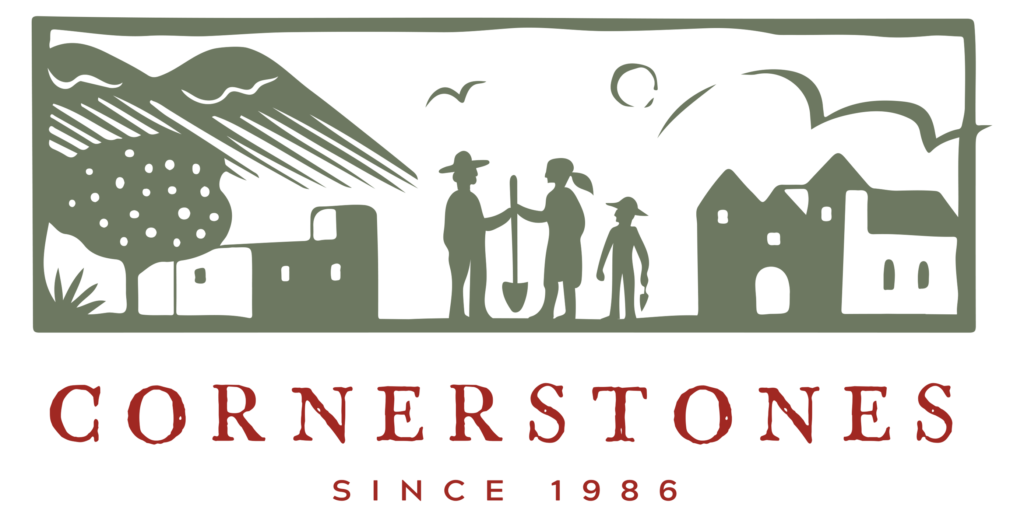Cornerstones’ heritage preservation work falls into two tracts. The first is what we call core mission projects. These are the preservation projects central to why we were founded 35 years ago: projects that are direct collaborations with community members to preserve their heritage. Recent examples of this work are Plaza del Cerro in Chimayo, churches in Mora County, and the Women’s Morada in Abiquiu. We fund these projects through generous gifts from individuals and companies as well as grants from foundations.
The other tract is projects that take place under the Cooperative Ecosystem Studies Units (CESU) Network. This is a nationwide group of organizations that collaborate with the federal government to steward many of our country’s natural and cultural resources. I love that we are part of this effort because it signals to me that Cornerstones is not only a “go-to” organization to care for some of our national heritage, but we are also seen as qualified to train others. An important part of these projects is conducting “hands-on” historic preservation training workshops on public lands for federal employees and volunteers. The federal government funds these projects.
We are currently working on CESU projects in California, Arizona, and New Mexico. In this column, I am focusing on one of them. Ryan Ranch in Joshua Tree National Park has an interesting story that illustrates one of the key periods in the recent history of the American West. But honestly, the motivation for this column came when I was preparing a slide show for a presentation. Many gorgeous photos of Ryan Ranch grabbed my attention.
Click to enlarge.
Photos by Issac Logsdon
The area that is now known as Ryan Ranch, or Lost Horse Valley, shows evidence of human impact at least 5,000 years ago by the Pinto Culture. They were followed by the Serrano, the Chemehuevi, and the Cahuilla groups. In the 1800s, cattlemen and miners began to occupy the land.
The discovery of the gold seam, and how Lost Horse Mine got its name, is a campfire classic that features several nefarious characters. The Ryan family - wealthy ranchers from Wyoming - purchased the mine sometime after 1895. In 1896, the Ryans built a residence from adobe bricks that contained some mine tailings.
The mine was successful for a short time, yielding 9,000 ounces of gold and a “respectable” amount of silver in the years between 1896 and 1899. When the original tunnel hit a geological fault, the miners were unable to locate the gold seam again. There were attempts to revive the mine in the early twentieth century, but it has been dormant since 1936.
According to a 1971 National Park Service inventory form, the ranch site consisted of “an adobe residence, two small adobe structures, a well, a graveyard and the remains of a corral.” F. Ross Holland, the historian who prepared the report, recommends a budget of $9,000 for emergency stabilization.
In 2003, the National Park Service listed the structures in poor condition. A team stabilized three adobe structures on the site in an effort to slow down the natural process of decay. Unfortunately, another issue was not so natural – the effects of vandalism. More preservation work was done by teams in 2006 and 2012.
Now, under the CESU program, Cornerstones is removing past preservation attempts, applying a clay-based plaster, cleaning out and improving the drainage system, and working with the Park to establish a cyclical maintenance program compatible with an unamended earthen plaster. Earthen structures require ongoing care. Part of this collaboration is the training and planning for this care so that this historically interesting and visually arresting ruin will continue to be a tangible connection to the history of American mining.
Last April, Issac Logsdon, Cornerstones Assistant Program Director, and Angela Francis, Cornerstones Lead Plasterer, led a workshop at Ryan Ranch. We call these sessions “workshops” because under the CESU program, training is an essential aspect. At the same time, these workshops provide considerable progress in preserving the site. The photos from that workshop are what led to this column. I will let them speak for themselves.
More information about CESU is available at: http://www.cesu.psu.edu/
There are several publications that tell the story of Ryan Ranch. This National Park Service Historic Structures report from 1969 is an enjoyable resource that is also an artifact of its time. http://npshistory.com/publications/jotr/hsr-lost-horse-mine.pdf
